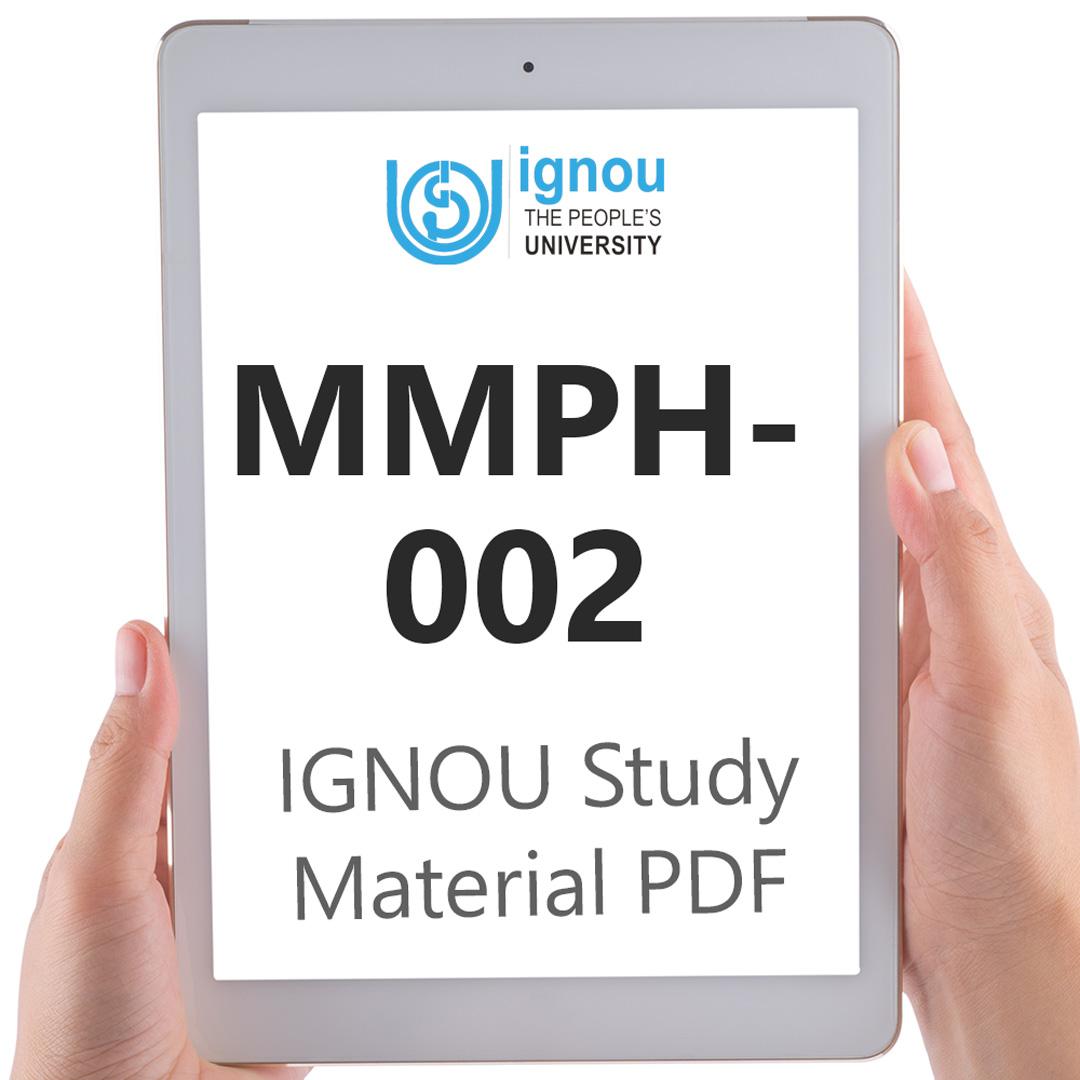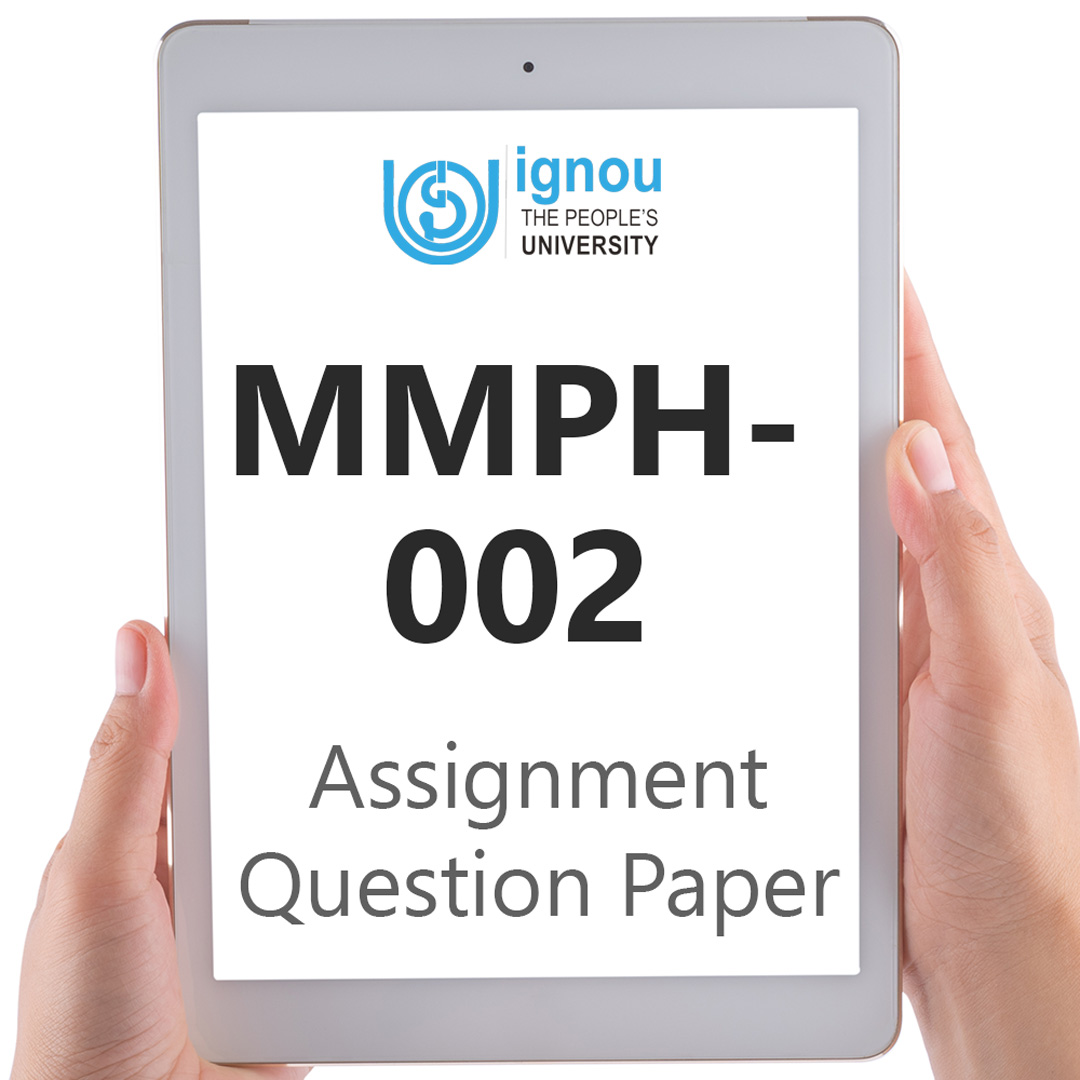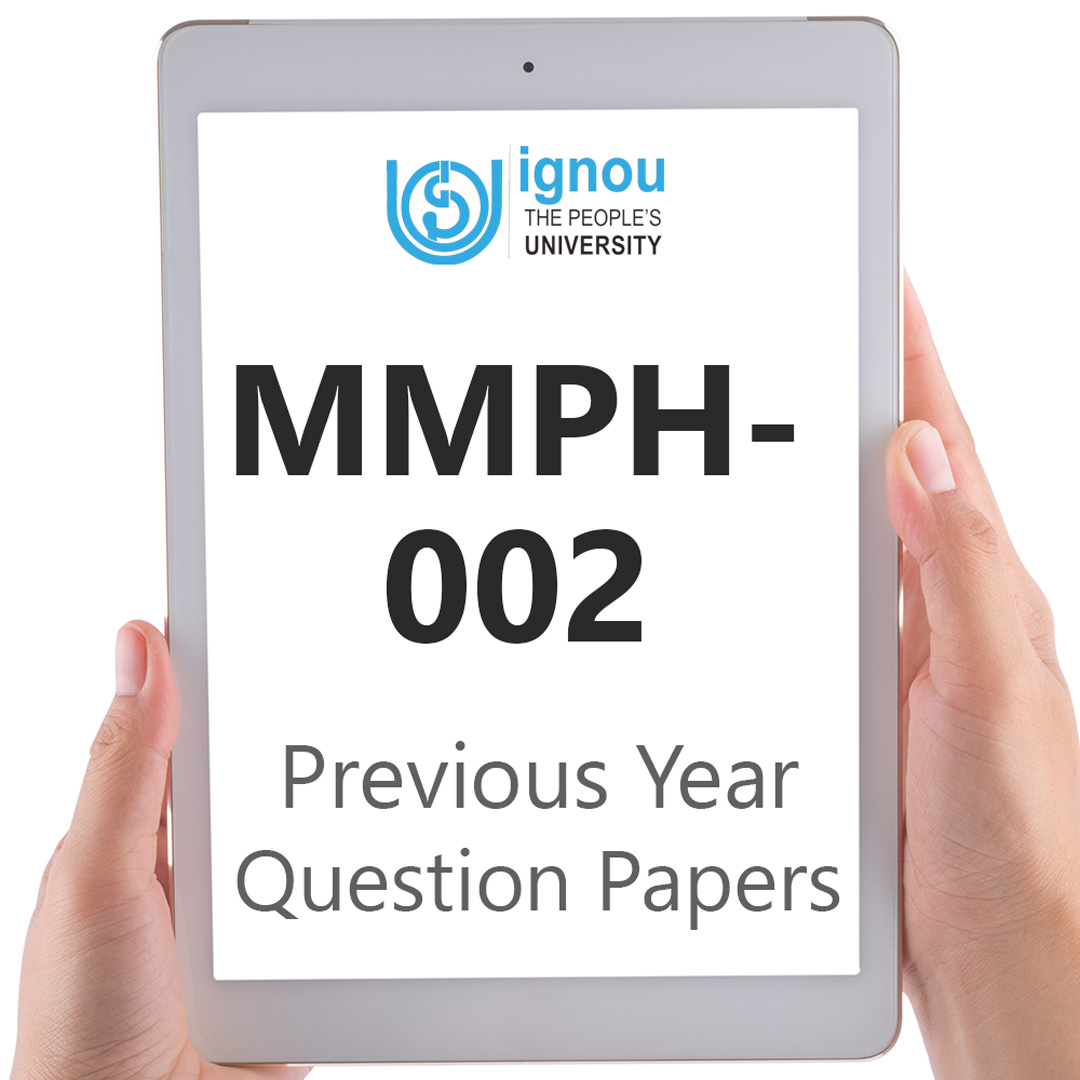If you are looking for MMPH-002 IGNOU Solved Assignment solution for the subject Human Resource Development, you have come to the right place. MMPH-002 solution on this page applies to 2022-23 session students studying in MBA, MBAHM, PGDIHRM courses of IGNOU.
MMPH-002 Solved Assignment Solution by Gyaniversity
Assignment Code: MMPH-002/TMA/JULY/2022-23
Course Code: MMPH-002
Assignment Name: Human Resources Development
Year: 2022-2023
Verification Status: Verified by Professor
Q1) Explain the Value anchored HRD process. How does the culture system of an organization influence the HRD system?
Ans) Value Anchored HRD (Human Resource Development) process is a strategic approach to HRD that focuses on aligning an organization's HRD efforts with its core values, beliefs, and culture. This approach ensures that the HRD interventions are closely aligned with the organization's vision, mission, and values, and that employees are trained and developed in ways that are consistent with these values. The value anchored HRD process has several steps that an organization can follow to align its HRD efforts with its values:
Identify the Organization's Values: The first step in the value anchored HRD process is to identify the core values of the organization. These values are the guiding principles that define the organization's culture, vision, and mission. Identifying these values is critical in designing HRD interventions that align with them.
Analyse the Current HRD System: The next step is to analyse the current HRD system to determine how well it aligns with the organization's values. This analysis should look at the types of training and development programs that are currently offered, how these programs are delivered, and the outcomes that they produce. The analysis should also consider the effectiveness of the HRD system in meeting the organization's strategic goals.
Design and Implement HRD Interventions: The third step is to design and implement HRD interventions that are aligned with the organization's values. These interventions should be designed to support the organization's goals, improve employee performance, and promote the values of the organization. The interventions can take many forms, including training programs, coaching, mentoring, and performance management systems.
Evaluate the Effectiveness of the HRD Interventions: The final step is to evaluate the effectiveness of the HRD interventions. This evaluation should measure the impact of the interventions on employee performance, the alignment of the HRD interventions with the organization's values, and the effectiveness of the HRD system in meeting the organization's strategic goals.
The culture system of an organization can influence the HRD system in several ways. The culture of an organization shapes the values and beliefs of its employees, and these values and beliefs are often reflected in the HRD interventions that are implemented. For example, if an organization values continuous learning and development, it is likely to invest in training and development programs that promote lifelong learning and skill development.
Similarly, the culture of an organization can impact the way in which HRD interventions are received and implemented. For instance, if the organization's culture is resistant to change or has a history of skepticism towards HRD initiatives, then it might be difficult to get employees to fully engage with HRD interventions. On the other hand, if the organization's culture is supportive of HRD initiatives, then employees are more likely to embrace them and take advantage of the opportunities provided.
Another way in which the culture system of an organization can influence the HRD system is through the leadership style of the organization. The leadership style of an organization can impact the HRD system by setting the tone for the organization's values and beliefs. If the leadership of an organization is committed to continuous learning and development, this commitment is likely to be reflected in the HRD interventions that are implemented.
Furthermore, the culture of an organization can also influence the HRD system through the behaviour of the organization's employees. If the culture of an organization is supportive of HRD initiatives, then employees are more likely to take responsibility for their own learning and development. Conversely, if the culture of an organization is not supportive of HRD initiatives, then employees are less likely to take responsibility for their own learning and development.
Q2) Explain how recent society has been going through a career transition in a career development process.
Ans) The last few decades have witnessed a significant shift in the career landscape, with society going through a career transition in the career development process. The transition has been driven by technological advancements, globalization, and changing workforce demographics. Some of the key factors that have contributed to this transition, the impact of the transition on individuals and organizations, and what the future of work might look like are as follows:
One of the most significant drivers of the career transition has been the rapid pace of technological change. The advent of new technologies such as artificial intelligence, automation, and machine learning has disrupted traditional industries and created new job roles. As a result, individuals have had to re-skill and upskill to stay relevant in the job market. Additionally, the gig economy has emerged as a new way of working, allowing individuals to work on short-term projects and earn income on a flexible basis. This has led to a shift away from traditional nine-to-five jobs, towards more flexible work arrangements.
Another factor contributing to the career transition has been globalization. The world has become increasingly interconnected, and businesses are expanding across borders. As a result, individuals are required to have a more global perspective and be able to work with people from diverse cultural backgrounds. This has led to the development of new skills such as cross-cultural communication, adaptability, and an understanding of international markets.
Furthermore, the changing demographics of the workforce have played a role in the career transition. The baby boomer generation is retiring, and millennials and Generation Z are entering the workforce. These younger generations have different expectations and values when it comes to work, and they prioritize things such as work-life balance, career development, and social responsibility. This has forced organizations to rethink their approach to talent management and adapt to the changing needs of their workforce.
The impact of the career transition has been significant for both individuals and organizations. Individuals have had to navigate a more complex job market, where job security is no longer guaranteed. They have had to adapt to new technologies and work arrangements, and constantly upgrade their skills to remain competitive. Organizations, on the other hand, have had to adopt new approaches to talent management, such as investing in employee development and creating a more flexible work culture. Failure to do so can result in a loss of talent to competitors who offer better opportunities for career development and work-life balance.
Looking towards the future, it is clear that the career transition is not a passing trend but a fundamental shift in the way we work. The rise of automation and artificial intelligence will continue to disrupt traditional industries, and individuals will need to be able to adapt to new job roles that require advanced technical skills. At the same time, the demand for soft skills such as creativity, critical thinking, and emotional intelligence will increase, as these skills cannot be easily replaced by machines.
In conclusion, the career transition that society has been going through in the career development process is the result of several factors, including technological advancements, globalization, and changing workforce demographics. The impact of the transition has been significant for both individuals and organizations, and the way we work will continue to evolve in the future. To navigate this transition successfully, individuals will need to be adaptable and constantly upgrade their skills, while organizations will need to invest in employee development and create a more flexible work culture.
Q3) Differentiate between coaching and mentoring? Briefly explain the coaching process.
Ans) Coaching and mentoring are two terms often used interchangeably, but they are not the same thing. Coaching is a process focused on helping individuals improve their performance in a specific area or achieve a specific goal, while mentoring is a more informal process focused on providing guidance, support, and advice based on the mentor's experience and knowledge. In this essay, we will differentiate between coaching and mentoring, explain the coaching process, and highlight some of the benefits of coaching.
Coaching is a structured process that involves a coach and a coachee working together to achieve a specific objective or improve performance. The coach provides guidance, support, and feedback to the coachee, helping them to identify their strengths and weaknesses and develop strategies to improve their performance. Coaching can be used in a variety of contexts, including sports, business, and personal development.
The coaching process typically begins with an initial meeting between the coach and the coachee to establish the goals and objectives of the coaching relationship. The coach will work with the coachee to identify their strengths and weaknesses and develop a plan of action to achieve the desired outcome. The coach will then provide ongoing support and feedback to the coachee, helping them to stay on track and make progress towards their goals.
The coaching process involves several key steps, including:
Assessment: The coach will work with the coachee to assess their current performance and identify areas for improvement.
Goal Setting: The coach and coachee will work together to establish specific, measurable, and achievable goals.
Action Planning: The coach and coachee will develop a plan of action to achieve the goals, including identifying specific steps, timelines, and resources needed.
Implementation: The coachee will take action to implement the plan, with the support and guidance of the coach.
Feedback and Evaluation: The coach will provide ongoing feedback and evaluation of the coachee's progress, helping them to identify areas for improvement and adjust the plan as needed.
One of the key benefits of coaching is that it provides individuals with a structured process for improving their performance and achieving their goals. Coaching can also help individuals to identify and overcome barriers to success, develop new skills and knowledge, and improve their confidence and motivation. In contrast, mentoring is a more informal process that involves a mentor providing guidance, advice, and support to a less experienced person. The mentor is typically someone with more experience or expertise in a particular area, and they use their knowledge and experience to help the mentee develop their skills and knowledge. Mentoring relationships can be formal or informal and can occur in a variety of contexts, including the workplace, academia, and personal development.
The key difference between coaching and mentoring is the level of structure and focus on specific objectives. Coaching is typically more structured and focused on achieving specific goals, while mentoring is more informal and focused on providing guidance and support based on the mentor's experience and knowledge.
Coaching and mentoring are two distinct processes that can be used to support individual development and improve performance. Coaching is a structured process focused on achieving specific objectives, while mentoring is a more informal process focused on providing guidance and support based on the mentor's experience and knowledge. The coaching process involves several key steps, including assessment, goal setting, action planning, implementation, and feedback and evaluation. Both coaching and mentoring can be valuable tools for personal and professional development, providing individuals with the support, guidance, and knowledge needed to achieve their goals and succeed in their chosen field.
Q4) How do organizational mission, and vision helps in formulating an organizational development plan?
Ans) Mission and vision statements are crucial to a successful corporate development plan. The mission statement explains why the organisation exists, whereas the vision statement describes its goals. A strategic organisational development plan specifies the steps needed to fulfil an organization's goals. The plan typically analyses the organization's strengths and weaknesses, identifies potential impediments, and develops tactics to attain the desired results. The mission and vision statements play a crucial role in the development of an organizational development plan in the following ways:
Provides a Clear Direction: The mission statement provides a clear direction for the organization and defines its core purpose. It outlines what the organization does, who it serves, and why it exists. The vision statement, on the other hand, describes the future state of the organization and what it aspires to achieve. Together, these statements provide a clear direction for the organization, which is critical for developing an effective organizational development plan.
Helps to Define Objectives: The mission and vision statements help to define the organization's objectives and provide a framework for setting goals. They serve as a guide for identifying what the organization wants to achieve and the steps required to get there. The objectives must be aligned with the mission and vision statements to ensure that they are consistent with the organization's purpose and long-term aspirations.
Provides a Basis for Decision Making: The mission and vision statements provide a basis for decision-making by establishing the organization's priorities and values. They serve as a guide for making decisions about which initiatives to pursue and which to avoid. For example, if the mission statement emphasizes the importance of customer satisfaction, the organization's development plan should focus on initiatives that improve customer service.
Motivates Employees: The mission and vision statements can be powerful motivational tools for employees. They provide a sense of purpose and direction, which can inspire employees to work towards achieving the organization's goals. When employees are motivated, they are more likely to be engaged, productive, and committed to the organization's success.
Shapes the Organization's Culture: The mission and vision statements play a significant role in shaping the organization's culture. They establish the organization's values and beliefs, which help to create a shared sense of purpose and identity. The organizational development plan must be consistent with the culture established by the mission and vision statements to ensure that the initiatives are well-received and supported by employees.
The organizational mission and vision statements are critical components of an organization's strategy and play a crucial role in developing an effective organizational development plan. They provide a clear direction, help to define objectives, provide a basis for decision making, motivate employees, and shape the organization's culture. When developing an organizational development plan, it is essential to ensure that it is consistent with the organization's mission and vision statements to ensure that it is aligned with the organization's purpose and long-term aspirations.
Q5) Explain the effectiveness of a balanced scorecard and Business Process Re-Engineering as a method to increase organizational performance.
Ans) The balanced scorecard and business process re-engineering (BPR) are two methods that organizations can use to increase their performance. The effectiveness of the balanced scorecard and business process re-engineering and how they can be used to improve organizational performance are as follows:
Balanced Scorecard
The balanced scorecard is a performance management tool that helps organizations to measure and manage their performance across multiple dimensions. It provides a balanced view of the organization's performance by considering four different perspectives: financial, customer, internal processes, and learning and growth. By using a balanced scorecard, organizations can ensure that their strategy is aligned with their objectives, and their performance is measured against a comprehensive set of metrics.
The effectiveness of a balanced scorecard can be seen in the following ways:
Improved Performance: The balanced scorecard helps organizations to improve their performance by providing a framework for setting and measuring objectives. By aligning the organization's strategy with its objectives, the balanced scorecard helps to focus the organization's efforts on the areas that are most critical for success.
Better Communication: The balanced scorecard promotes better communication within the organization by providing a common language and framework for discussing performance. It helps to ensure that everyone is working towards the same goals and objectives, and that there is a shared understanding of how performance will be measured and evaluated.
Better Decision Making: The balanced scorecard provides decision-makers with the information they need to make informed decisions about the organization's strategy and operations. By considering multiple perspectives and metrics, decision-makers can ensure that they are making decisions that are aligned with the organization's overall objectives and priorities.
Business Process Re-Engineering: Business process re-engineering is a method for redesigning an organization's business processes to improve performance and reduce costs. It involves the radical redesign of processes and workflows to eliminate unnecessary steps and streamline operations. BPR is typically used when organizations need to make significant changes to their processes, such as when implementing new technologies or entering new markets.
Business Process Re-Engineering
The effectiveness of business process re-engineering can be seen in the following ways:
Improved Efficiency: Business process re-engineering helps organizations to improve their efficiency by eliminating unnecessary steps and reducing duplication. By streamlining processes, organizations can reduce the time and resources required to complete tasks, which can lead to significant cost savings.
Improved Quality: Business process re-engineering can help organizations to improve the quality of their products and services by ensuring that processes are designed to deliver the highest quality outcomes. By focusing on process improvements, organizations can reduce errors and defects, which can improve customer satisfaction and loyalty.
Increased Flexibility: Business process re-engineering can help organizations to increase their flexibility by designing processes that can adapt to changing market conditions or customer needs. By creating more agile processes, organizations can respond more quickly to changing circumstances and take advantage of new opportunities.
Increased Innovation: Business process re-engineering can help organizations to increase their innovation by creating a culture that encourages experimentation and risk-taking. By redesigning processes to support innovation, organizations can create an environment that fosters creativity and allows new ideas to flourish.
Both the balanced scorecard and business process re-engineering are effective methods for improving organizational performance. The balanced scorecard provides a comprehensive framework for measuring and managing performance across multiple dimensions, while business process re-engineering focuses on streamlining processes and eliminating waste. By using these methods, organizations can improve efficiency, quality, flexibility, and innovation, which can lead to increased profitability and competitiveness.





